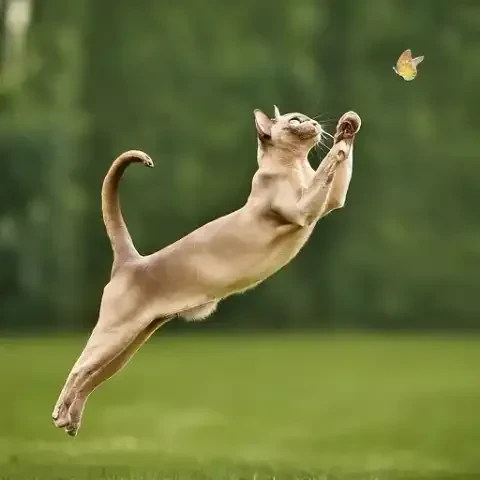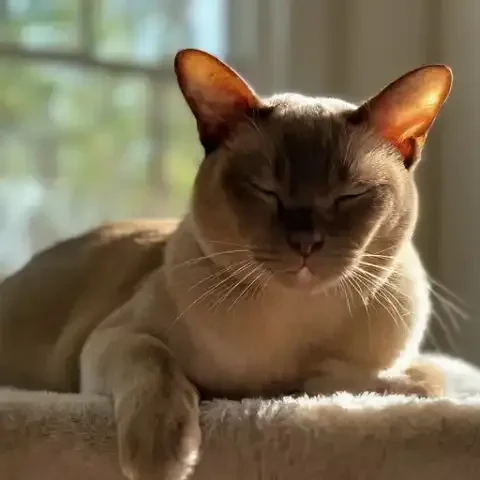Picture this: a cat, perhaps startled from a nap on a windowsill, tumbles earthward. For a heart-stopping moment, gravity seems to have won. But then, something extraordinary happens. In mid-air, the cat twists, contorts, and in what seems like an impossible feat of aerial acrobatics, lands gracefully on all four paws, seemingly unfazed. Is it magic? A feline superpower? While it might appear that way at first glance, the secret behind this gravity-defying act is not mystical, but deeply scientific. It's a remarkable interplay of anatomy, physics, and evolution known as the “cat righting reflex.” This innate ability to orient themselves during a fall is a testament to nature's ingenuity, a perfect blend of biological design and physical principles that allows cats to navigate their world with unparalleled agility and grace. This article will unravel the fascinating science behind the cat righting reflex, peeling back the layers of this seemingly magical ability to reveal the intricate biological machinery and elegant physics that make it possible. We’ll delve into the flexible spine, the intricate balance system within the inner ear, and the surprising physics of angular momentum, ultimately understanding how these elements combine to allow cats to consistently land on their feet. Join us as we explore this captivating phenomenon, celebrating the scientific marvel hidden within the everyday elegance of our feline companions.
The foundation of the cat's remarkable righting ability lies within its unique biology, a symphony of specialized anatomy and highly attuned senses. Central to this is the feline spine, a masterpiece of flexibility. Unlike humans and many other mammals, cats boast a significantly increased number of vertebrae – up to 53 compared to our mere 33. This elongated spinal column, coupled with exceptionally elastic discs nestled between each vertebra, grants cats an unparalleled range of motion and rotation. Imagine each vertebra as a tiny building block, and the elastic discs as flexible joints between them. The more building blocks and the more flexible the joints, the greater the overall flexibility. This remarkable spinal flexibility is not just about showing off impressive stretches; it is absolutely crucial for the complex contortions required during the righting maneuver. It allows the cat to dramatically twist and bend its body in mid-air, segmenting itself in ways that are simply impossible for creatures with stiffer spines. This flexibility is the biological scaffolding upon which the entire righting reflex is built.
Complementing this flexible spine is the exquisitely sensitive vestibular system, the inner ear's sophisticated balance command center. Found in all mammals, the vestibular system is responsible for our sense of balance and spatial orientation, acting as a constant internal compass. Within the cat's inner ear, specialized structures – the semicircular canals and otolith organs – are exquisitely attuned to head position and movement. The semicircular canals, filled with fluid, detect rotational movements like tilting or turning the head, while the otolith organs sense linear acceleration and changes in head position relative to gravity, essentially telling the cat which way is "up" and which way is "down." These sensory organs are not passive detectors; they are dynamic information gatherers, constantly feeding signals to the brain about the cat's orientation in space. It’s these signals, transmitted at lightning speed to the brain, that serve as the initial spark for the righting reflex. The vestibular system acts as the trigger, alerting the cat to its disorientation and initiating the cascade of coordinated movements that will bring it back to an upright posture.
Once the vestibular system has signaled the need to right itself, the cat’s body responds with astonishing speed and precision, thanks to rapid muscle action and intricate coordination. Cats are equipped with a high proportion of fast-twitch muscle fibers, specialized muscle cells that contract quickly and powerfully, enabling rapid and agile movements. These are the muscles that power a cat's lightning-fast pounces, their acrobatic leaps, and, crucially, their mid-air righting maneuvers. The brain acts as the conductor of this muscular orchestra, orchestrating the coordinated contractions of muscle groups throughout the body. It’s not simply about raw muscle power; it’s about precise timing and sequence. The brain sends a flurry of signals, activating muscles in the neck, back, limbs, and tail in a precisely choreographed sequence to execute the complex twisting and turning motions required for righting. This neurological and muscular symphony unfolds in fractions of a second, demonstrating the incredible efficiency and speed of the feline nervous system and musculature.
The role of the tail in the righting reflex is often debated and sometimes overemphasized. Popular perception often credits the tail as the primary balancing tool, the key to the cat’s mid-air acrobatics. While the tail can assist with balance adjustments, particularly for fine-tuning orientation in mid-air, it is not the primary engine of the righting reflex. Tailless cats, such as Manx breeds, are still perfectly capable of righting themselves, demonstrating that the reflex is fundamentally independent of tail function. However, for cats with tails, it does serve as a valuable counterweight and a tool for making minor adjustments during the fall. Imagine a tightrope walker using a long pole to maintain balance; the cat's tail functions in a similar, albeit less crucial, way. It can be subtly shifted and rotated to influence the cat's center of gravity and make small corrections to its orientation as it rotates. The tail, therefore, is more of a refinement tool, enhancing the efficiency and precision of the righting reflex rather than being its primary driver. The core mechanism resides in the interplay of the spine, vestibular system, and coordinated muscle action, with the tail offering supplementary assistance for optimal landings.
The biological components are only half the story; the other crucial half lies in the elegant physics that underpin the cat righting reflex. At the heart of this physics is the principle of conservation of angular momentum, a fundamental law of motion that governs rotating objects. Angular momentum, in simple terms, is the measure of how much an object is rotating. Think of it as the "spinning inertia" of a rotating object – its tendency to keep spinning at the same rate and in the same direction unless acted upon by an external force. A familiar analogy to illustrate this principle is a spinning ice skater. When a skater spins with their arms outstretched, they rotate relatively slowly. But when they pull their arms in close to their body, their spinning speed dramatically increases. This happens because angular momentum must be conserved. By reducing their moment of inertia (resistance to rotational motion) by pulling their arms in, their rotational speed must increase to maintain the same overall angular momentum. In the case of a falling cat, it’s a closed system – once airborne, the cat is essentially in freefall, with only negligible air resistance acting as an external force in the timeframe of the righting reflex. Therefore, the total angular momentum of the cat remains essentially constant throughout the fall. The cat, ingeniously, exploits this principle to reorient itself.
The key to the cat's physics-defying feat is its clever body segmentation and rotation, enabled by its flexible spine. Upon sensing its disorientation via the vestibular system, the cat initiates a sequence of movements to redistribute its mass and generate rotation without violating the law of conservation of angular momentum. It essentially segments its body into two halves – the front half and the rear half – using its flexible spine as a hinge. The sequence begins with the cat determining "up" and "down" using its vestibular system. Then, the magic starts. The cat tucks its front paws towards its chest, effectively reducing the rotational inertia of its front half. At the same time, it extends its hind legs, increasing the rotational inertia of its rear half. Now, for the clever part: the cat rotates its front and rear halves in opposite directions. Because angular momentum must be conserved and there's no initial external torque to start rotation from rest, rotating the front half clockwise, for example, will necessitate an equal and opposite counter-clockwise rotation of the rear half to maintain a net angular momentum of (close to) zero. By carefully coordinating these opposing rotations of its segmented body, the cat can effectively reorient its entire body, rotating its front half to face downwards, and then bringing its rear half to follow suit, all while conserving the total angular momentum of its system. It’s a breathtaking display of physics in action, executed with innate grace and precision.
The cat's righting maneuver is not a single, rigid movement, but a fluid and adaptable “bend and twist” sequence. Imagine a wave traveling down the cat's spine. The process is initiated in the front part of the body, with the head and forelimbs rotating first, followed by a wave-like motion that travels down the flexible spine towards the hindquarters. This wave-like motion is crucial for controlled and rapid rotation, allowing for a smooth and efficient righting maneuver. Throughout the fall, the cat continuously adjusts its body configuration to fine-tune its orientation. It can extend or retract its limbs, arch or straighten its back, and subtly adjust its tail position to control the speed and direction of its rotation. This constant feedback and adjustment, guided by the vestibular system and processed by the brain, ensures that the cat lands on its feet with remarkable consistency, even when starting from various initial positions or experiencing slight disturbances during the fall. It’s a dynamic and adaptable process, not a fixed routine, showcasing the cat's incredible ability to respond to changing conditions in real-time.
Crucially, the speed and time involved are critical factors for the success of the righting reflex. The entire righting maneuver unfolds in an incredibly short timeframe – often within fractions of a second. This necessitates not only rapid muscle contractions and neural processing but also a sufficient amount of time to complete the complex rotations. This is why height matters. There is a minimum height required for the righting reflex to be fully effective. The cat needs enough time during the fall to execute the entire sequence of movements necessary to reorient itself. Falls from very low heights, such as toppling off a low stool, may not provide sufficient time for the cat to fully right itself before impact. In such cases, the reflex may not be fully completed, potentially leading to awkward landings or even injuries. This underscores the fact that while the saying "cats always land on their feet" is a common generalization, it's not an absolute guarantee in every single situation. The righting reflex is incredibly reliable within its operational parameters, but it is still governed by the laws of physics and the constraints of time and space.
The cat righting reflex, while a marvel of biological engineering, is not simply a pre-programmed routine; it also involves elements of development and refinement. While the fundamental circuitry for the reflex is largely innate, genetically encoded within a cat's DNA, kittens are not born fully proficient in this aerial artistry. Like many innate behaviors, the righting reflex requires practice and experience to reach its full potential. Kittens begin to develop the righting reflex around 3-4 weeks of age, coinciding with the maturation of their vestibular system and the development of muscle coordination. Initially, their attempts may be somewhat clumsy and uncoordinated, but through constant practice, they gradually refine their technique. Play becomes a crucial training ground. Kittens instinctively engage in play behaviors like tumbling, chasing, and climbing, which inadvertently provide opportunities to practice and hone their righting reflex. These playful tumbles and falls are not random; they are essential learning experiences, allowing kittens to develop the neural pathways and muscle memory necessary for effective righting. Play with mothers and siblings further enhances this development, fostering coordination, spatial awareness, and a sense of body control in dynamic situations. By around 7 weeks of age, the righting reflex is typically fully developed and functional, reaching a level of proficiency that allows adult cats to execute their gravity-defying landings with such apparent ease. Even though the core programming is innate, the journey from clumsy kitten to graceful aerialist highlights the importance of development and experience in perfecting this remarkable feline ability.
Despite its remarkable reliability, the cat righting reflex is not without its limitations and imperfections. As we've discussed, height is a crucial factor. Insufficient time during very short falls can prevent the reflex from fully executing, making low falls potentially more dangerous than falls from moderate heights where the cat has ample time to right itself. Age and health also play a significant role. In older cats, the effectiveness of the reflex can naturally decline. Muscle mass decreases, flexibility diminishes, and the vestibular system may become less sensitive with age, all impacting the speed and efficiency of the righting maneuver. Injuries or illnesses that affect balance, coordination, or muscle strength can also impair the reflex, making it less reliable or even non-functional in certain cases. While generally robust, external conditions and the cat’s initial state can also play a minor role. For example, if a cat is initially spun into a very fast rotation or encounters unusual air currents during a fall, it could potentially affect the reflex's efficiency in rare and extreme scenarios. However, in typical everyday falls, the reflex is remarkably resilient and effective. It’s essential to remember that the righting reflex, while an incredible adaptation, is not an infallible superpower. It is a highly effective biological and physical mechanism that works within certain parameters and can be influenced by various factors.
The evolutionary origins of the cat righting reflex are deeply intertwined with the feline lineage and their ecological niche. The reflex is strongly linked to the arboreal ancestry of cats and their historical adaptation to tree-dwelling lifestyles. Early cats likely evolved in environments with trees and rocky terrain, where climbing and leaping were essential for both hunting prey and escaping predators. In such environments, the ability to survive falls from heights would have been a significant survival advantage. A cat that could consistently land on its feet after a fall from a tree branch would be far more likely to survive, reproduce, and pass on its genes, including those responsible for the righting reflex. Thus, natural selection favored individuals with more effective righting reflexes, leading to the refinement and preservation of this remarkable ability over evolutionary time. Beyond arboreal life, the righting reflex also enhances feline agility, a crucial trait for their predatory lifestyle. Agile movements, quick turns, and controlled landings are essential for hunting fast-moving prey and for escaping larger predators. The righting reflex contributes to this overall agility, allowing cats to maintain their speed and maneuverability even after a fall or jump. In essence, the cat righting reflex is a testament to the power of evolution, a beautiful example of how natural selection can shape biological and physical traits to enhance survival and reproductive success. It’s a reminder that even seemingly simple observations about animal behavior can reveal profound insights into the intricate dance between biology, physics, and the relentless forces of evolution.
So, the next time you witness a cat seemingly defy gravity and land gracefully on its feet, remember that it’s not magic, but a mesmerizing blend of specialized anatomy, clever physics, and millions of years of evolutionary refinement. The flexible spine, the sensitive vestibular system, the principle of angular momentum, and the selective pressures of evolution have all conspired to create this truly remarkable ability. The cat righting reflex is a testament to the intricate and ingenious adaptations found throughout the natural world, a reminder that even in the seemingly mundane actions of everyday animals, there lie profound scientific principles waiting to be discovered and appreciated. It's a marvel of nature that invites us to look closer, to ask questions, and to celebrate the brilliance of the living world, one gravity-defying feline at a time.







